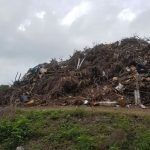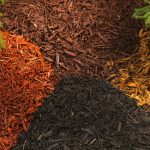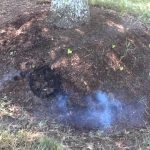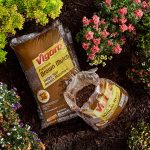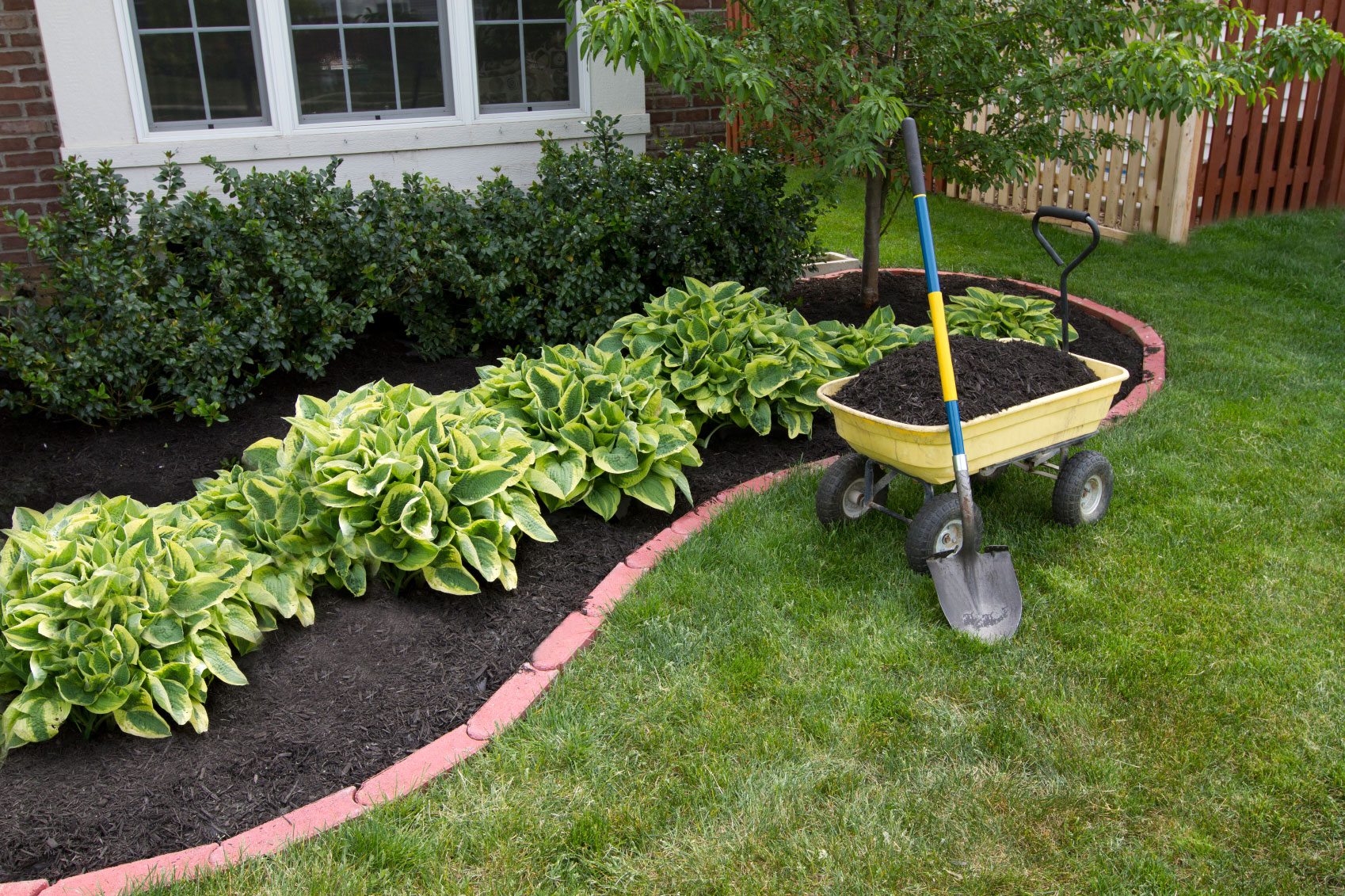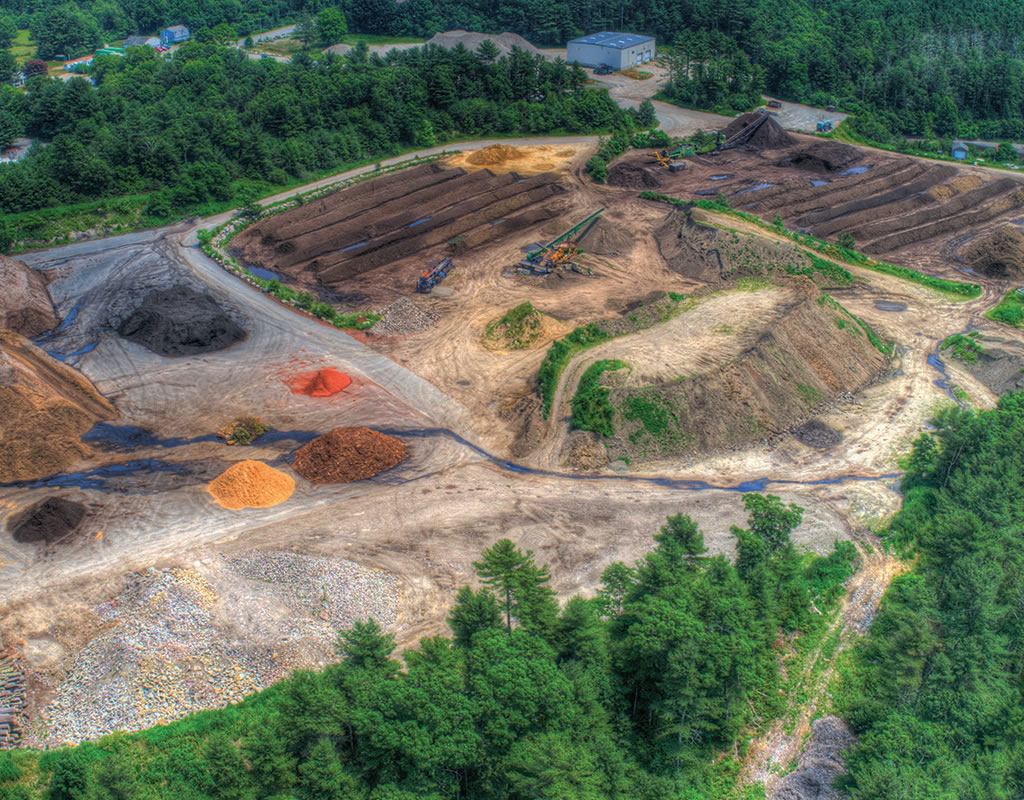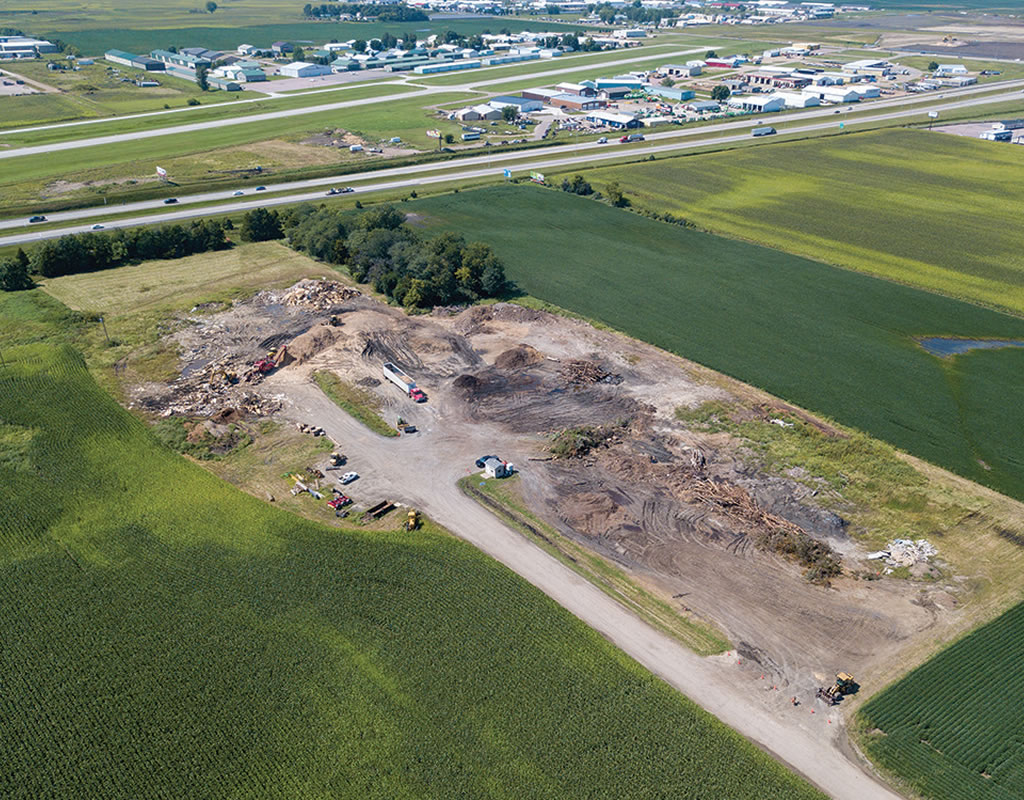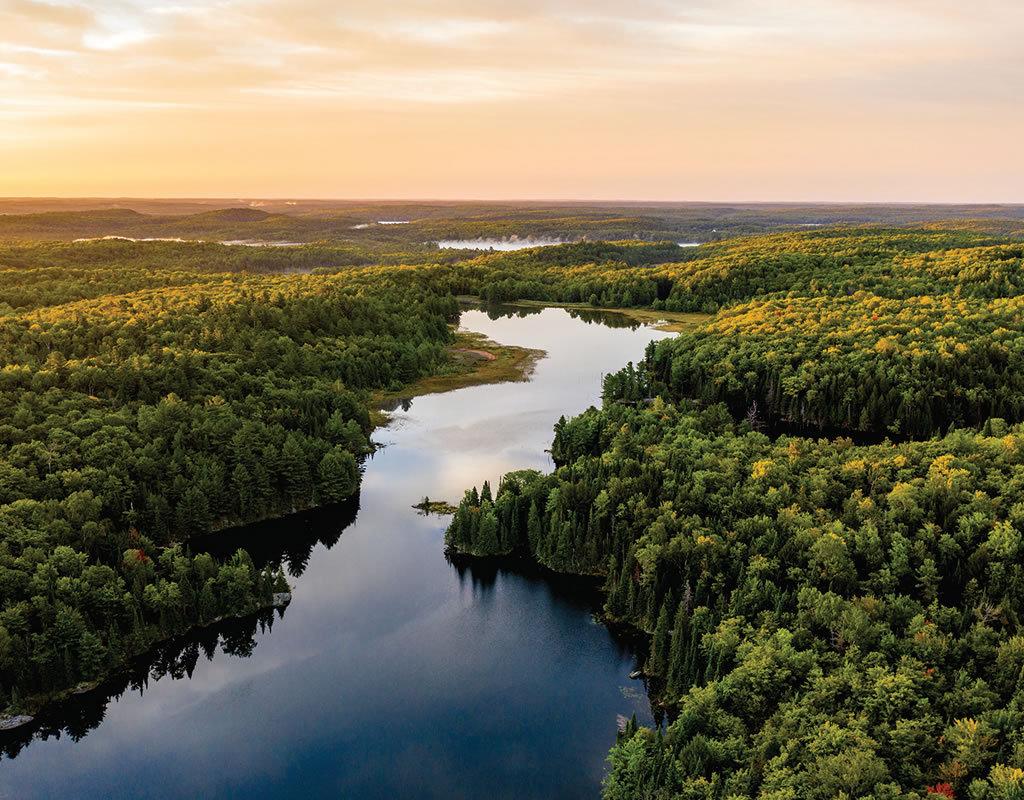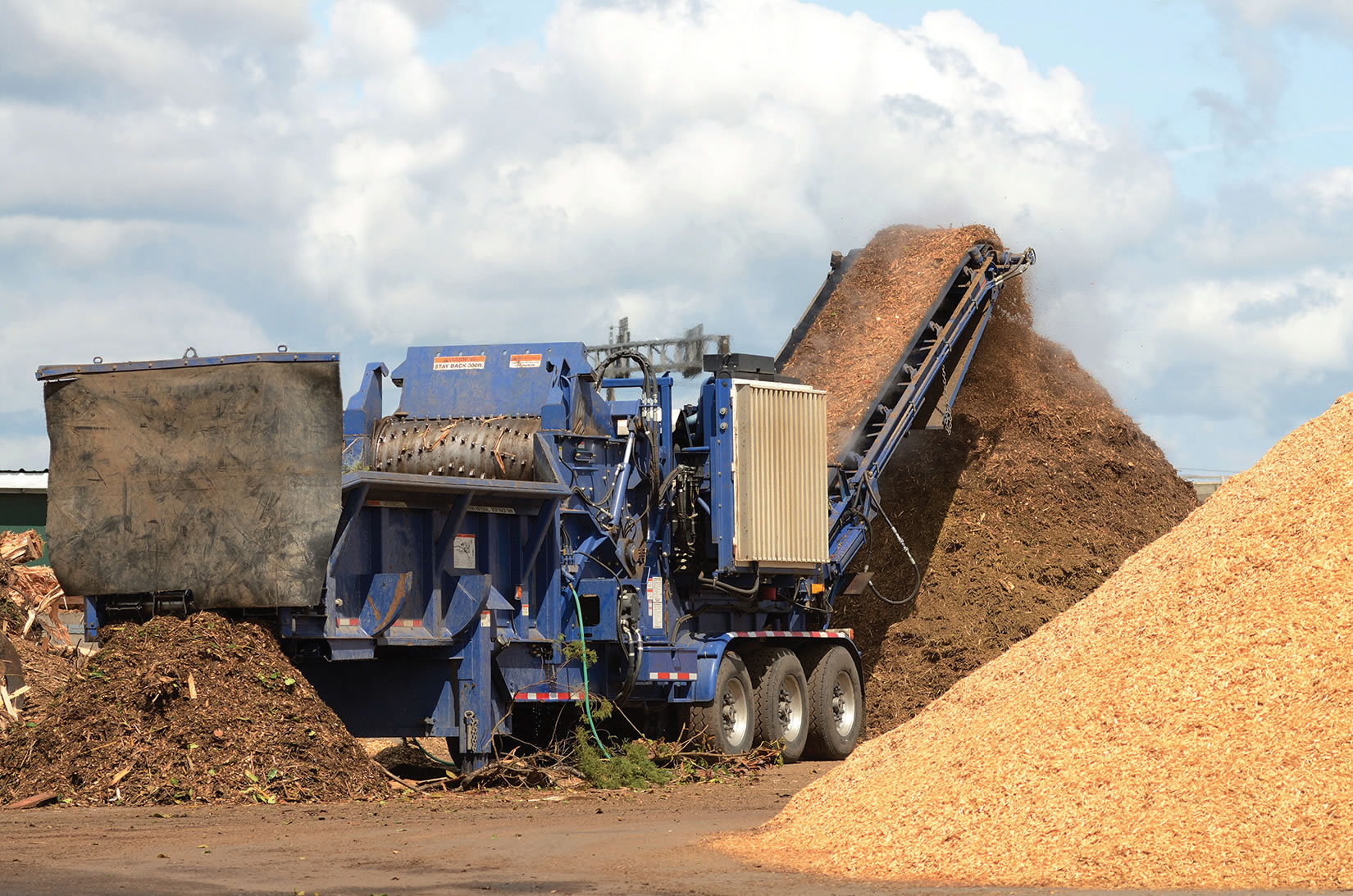By Ken McEntee
In theory, expanding a mulch producing operation into compost production sounds like an ideal way to add an additional revenue stream. Unfortunately, say some people in the mulch business, the complications of permitting and the expense of purchasing composting equipment often can make compost production more trouble than it’s worth.
Others, however, say that restricting feedstock to yard waste and landscaping debris, and working in a market with a strong demand for compost, can make the expansion lucrative.
“I’ve seen a handful of mulching operations get into composting over the last few years, but it’s usually a way to get rid of the fines from their grinding operation,” said grinding expert Dave “The Grinder Guy” Whitelaw, who hosts a website called “Ask the Grinder Guy” (www.askthegrinderguy.com). “Composting is not always the best business to get into, because compared to mulch, you’re not going to get the same return. When you grind a tree and sell it for mulch you’re using the whole tree - 100 percent of the material. But if you spend the time to compost it, it composts down to 50 percent of what it used to be and you may end up selling it for less than what you’re getting for your mulch. On the other hand, what happens at mulching facilities is you want to screen the fines of the mulch before you color it to save money on the colorant and on the weight of hauling. Then you have to do something with the fines. So some people will get into composting just because of that.”
The availability of carbon-rich wood could make a grinding operation a natural venue to get involved in food waste composting – a business that is likely to grow in the short term as more states consider banning food scraps from landfills.
“With food waste you need to be sure you have enough carbon bulking agents,” said Kevin Tritz, owner of Specialized Environmental Technologies (SET), which operates The Mulch Store, a compost producer with four locations in the Minneapolis area. “If you have a mulching operation you probably already have access to sawdust or wood chips to use as a bulking agent.”
The feasibility of such an operation, Whitelaw said, can depend on the costs of buying composting equipment and the possible need for composting permits.
“For a small amount of material, your front-end loader may be sufficient to turn compost piles, saving the expense of buying a windrow turner, for example,” he said.
Keep it simple
Most sources contacted for this article agree that restricting compost production to yard and landscaping materials would be less costly and complicated than getting involved with processing other organics, like food waste or biosolids.
“Getting involved in organics processing throws you into a whole new category and requires more permits and state inspections and things like that,” said Tritz. “In most states you need to process organics on impermeable pads and you need to manage your runoff and meet certain criteria for temperature for reduction of pathogens. There are a lot of records you need to keep. Each state is different so you have to check out your permitting requirements. So composting is a lot more sophisticated than making mulch.”
That, Whitelaw said, is why mulching operations that are considering an expansion into composting, would be wise to “keep it simple and stick to yard waste.”
“If your goal is to get rid of your fines and make a little money in the process, then you should be able to do that without a lot of complication,” he said. “You might want to let the material compost in piles, but it’s going to take some time. When you’re grinding up a tree, there isn’t any nitrogen there for the composting process. After a period of time, you may have a good soil amendment to sell, but is it technically compost? Maybe it depends on what state you’re in. There are a lot of different things that people say are compost around the country, and most of them aren’t really compost. Just because it sits in a pile for a year doesn’t make it compost.”
Amerigrow Recycling, a mulch producer in Delray Beach, Fla, makes a compost type of product with static piles.
“We make a nice back-end, black dirt product called Eco-Soil that takes 18 to 24 months by static windrow composting,” said Dave Tomlinson, vice president of operations for the Amerigrow. “We’re not doing the active windrows and taking time and temperature and testing and all that. If you brought a compost expert in here they would say, ‘No, no, no. You’re not doing it right.’ But there are a lot of people who want to buy it because they know it’s a high quality product. And if we called it compost we would have to send reports in to the water management district and all of that stuff.”
In contrast to a mulch producer considering expanding to composting, Amerigrow went in the opposite direction. The site was loaded with yard waste it accepted – along with tipping fees – for years before the present ownership bought the “landscape dump” in 1995.
“There was a lot of crap piled up,” Tomlinson said. “We came in and started to grind it and compost it, but eventually focused on building up the mulching side of things. Once that started to take off we went from bulk mulch to bagged mulch to blower mulch.”
Later, the company expanded into commercial soils.
“It wouldn’t make sense for us to do active windrow composting,” Tomlinson said. “Out of our $17 million in annual revenue, composting generates maybe $500,000. Ninety percent of our commercial soils clients do not have compost in their commercial mixes. If I were to do an active windrow, I would require twice as much room for probably the same amount of revenue.”
Amerigrow produces more than 300,000 yards of mulch annually, Tomlinson said.
Location is a key
Location, he said, is a main factor in the decision to produce compost.
“Florida is not the greatest compost market because you can plant a tree in the sand down here and if it gets water and nutrients it’s going to grow,” he said. “But if you’re in Georgia or North Carolina, you can’t just plant a tree in the clay soil. You need to use some sort of soil amendment.”
If you’re in a location with good demand for soil blends, composting can be a sound investment, Whitelaw said.
“If you already have the customer base, it’s an add in,” he said. “But you don’t get the high return from just compost. If you get involved in mixing or making a soil blend or a potting soil, that’s when you’re going to get your higher return. But you have to make an investment to get that return. You don’t necessarily need a windrow turner for yard waste composting because that material stays fairly loose. But sludge or food waste, because it is so high in moisture, it chokes off the air in a windrow, so you’re going to need to invest in a windrow turner if you’re going to process sludge or food waste.”
Developing a market for compost, Tritz says, can take time and patience.
“When we first started we could hardly give the stuff away,” he said, “Today we produce 100,000 tons a year and have a variety of products, like erosion control products. Over the years people need to be educated how to use the material.”
Location also will determine what regulatory hoops a new composting operation may need to navigate.
“One of the biggest challenges is basically where you are located,” Tritz said. “Every state has its own permit requirements. There are not as many permit requirements on mulches as there are on compost, so the first thing, before you get into composting, is you have to check on your level of requirements.”
According to Frank Franciosi, executive director of the U.S. Composting Council (USCC), “Composters have totally different permitting compared to mulch producers. A lot of the chip and grind operations, depending on the state they are in, are permit by rule and they basically stay under the radar. Once you start bringing in feedstock’s other than land clearing debris and yard waste you start to get into permitted facilities and you may need an engineering firm, and you need to worry about stormwater management and odor management.”
Like Amerigrow, SET started as a composting operation and added mulch to its product line later, although the company doesn’t grind its own mulch.
Do it right
Tritz, a former president of the USCC, said anybody who wants to get into the composting business should learn to do it properly.
“There are several different opportunities out there in the composting industry where there are training sessions to actually learn to do it the right way,” he said. “If you don’t do it right you can run into some huge problems with odor which shuts you down really fast. Many people have gone out of business simply because of problems with their neighbors. We go through great strides to make sure we don’t run into that odor problem, meaning mixing the material right and getting it mixed right away and watching our piles and making sure we have the right carbon to nitrogen ratio.”
A good first step when expanding into composting, said Frank Franciosi, executive director of the USCC, is to take one of the council’s Compost Operator Training Courses. Weeklong courses in 2018 are scheduled in Davis, Calif., East Lansing, Mich. and Raleigh, N.C.
“A big part of composting is understanding the biology; not having it too wet or too dry and understanding how to balance things out,” Franciosi said. “It’s an art and a science, and at the same time a lot of it is trial and error. If you spend the $650 to $700 to take the course you’re going to get your money back because you’re going to avoid a lot of mistakes and some of the problems down the road.”
Some states, Franciosi said, offer a demonstration permit, through which composters can experiment with various feedstock.
“A lot of times, expanding from yard waste into food waste or other organics might be biting off more than you can chew,” he said. “But with a demonstration permit, maybe I am processing yard waste, and a grocery store approaches me with some produce waste. I can set up a trial under a demonstration permit to see how it works out. With compost, you can get a good dollar back if your product is good and consistent. If it isn’t, then you’re going to give it away.”
Bombaci Mulch, of Essex, Conn., is a small husband and wide mulch operation that has made the expansion into composting. The company started grinding in 1991 and expanded into compost about 10 years ago and now sells about 500 yards per year.
“It’s mostly leaves that we put in a windrow and turn with an excavator,” Kenn Bombaci said. “We sell it for $30 a yard.”
Bombaci and his wife, Martha, started by dumping leaves delivered by landscaping contractors in a field.
“We turned it over one day and said, ‘Wow, this is good stuff,” Bombaci said. “We do it on a farm so we don’t need a permit. It has been a good move. I wish I could sell more, then I could make more. It has been slow to catch on.”
Along with the excavator, which they already had, the Bombacis purchased a screener, which they now use to screen compost and topsoil.
“I started looking into food waste, but that is a whole other deal,” he said. “You have to go pick it up and look into permits. It’s a whole new investment and the government gets involved. It seemed like a real ordeal. With leaves there is no smell or rodents or animals. I don’t have to pick it up.”
Compared to the 500 yards of compost the company sells annually, it sells about 7,000 yards of mulch, which they process with a tub grinder.
Ken McEntee is editor and publisher of Composting News (www.compostingnews.com).
Related News
Subscribe Today
Every other month, Soil & Mulch Producer
News brings you important stories about:
• New Technology
• Products
• Industry News
• Research Studies
Soil & Mulch Producer News features articles and services relevant to your daily operations.

